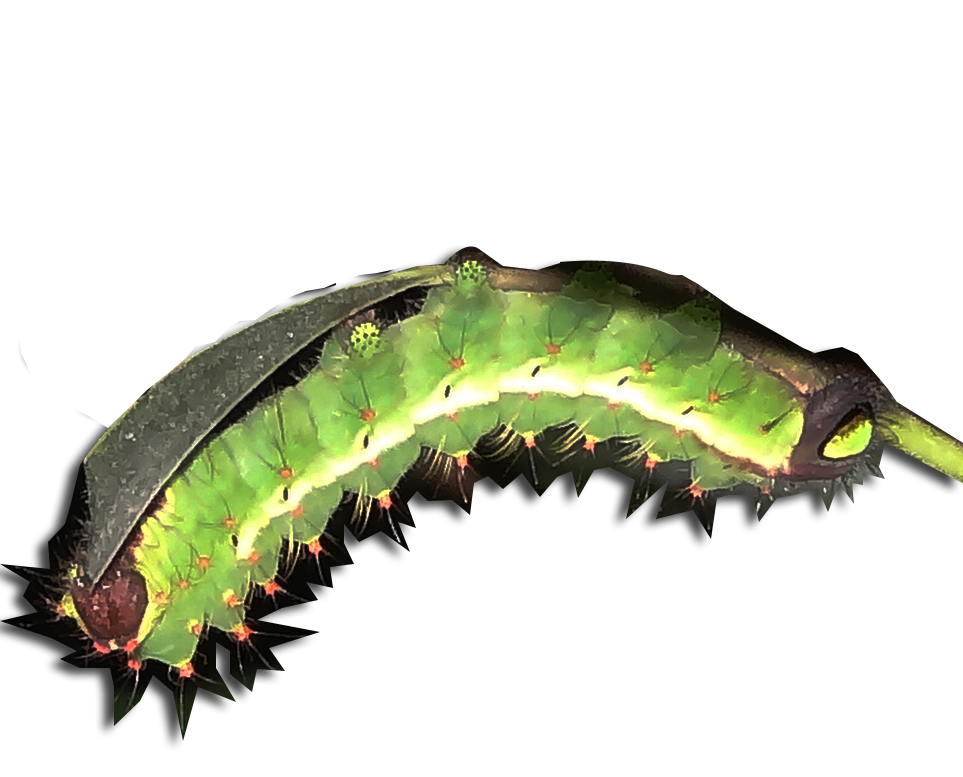Allied Sectors and Occupations
Silkworm Seed/Egg Production
Mulberry Seed/Egg Production
Disinfection of grainage and implements
- Bamboo made house with thatched roof and mud-plastered wall is preferable for grainage.
- Disinfect the grainage rooms and appliances prior to commencement of operation.
- Wash the rooms and appliances with 5% bleaching powder solution before one day.
- Dry the appliances in sun shine for 3-4 hours before one day.
- Disinfect the rooms and appliances with a mixture of 2% formalin, 0.5-1% lime and 0.5% detergent solutions @ 1L/ sq.m after one day.
Pupal examination
- Separate out the melted, flimsy and good cocoons.
- Take out the gut portion and observe under microscope.
- Reject the lot in case there is incidence of pebrine.
- Disinfect the contaminated room before the arrival of new lots.
Preservation and protection of seed cocoons
- Immediately after the receipt of seed cocoons, spread them on trays in a
single layer to facilitate good aeration. - Reject the seed cocoons which are melted, uzi infested, flimsy and not conforming to the characteristics of parent races.
- Preserve only the healthy seed cocoons in trays for further processing.
- Provide cross ventilation in the preservation room.
- Maintain temperature at 25 ± 1˚C, relative humidity of 75 ± 5%, 16 hour light and 8 hour dark conditions in the cocoon preservation room.
- Maintain complete darkness one day prior to emergence to avoid irregular emergence of moths.
Early eclosion/ artificial eclosion/ forced eclosion of moths
- This helps in determining the disease freeness of a batch and helps in
minimizing the loss to grainage. - For early emergence of moths, 50-60 seed cocoons are taken from individual lots and placed into an artificial eclosion box.
- Maintain the temperature at 32-33 0C with the help of thermostat. This accelerates the development of pupae and moth emerges early.
- Examine the early emerged female moths of respective lots are under microscope to know the disease freeness of lots.
Synchronization of emergence of moths, pairing, depairing and oviposition
- Keep the cocoon preservatio0n room dark before the expected day of emergence
of moths. - In case of variation in development of male or female pupae, the development of male pupae can be arrested by preserving them at 5-7 0C and 75 + 5% relative humidity for 3-4 days.
- Only healthy and active moths are taken for pairing.
- After 1-2 hours of emergence, the male and female moths of respective combination are allowed for 3.5 to 4 hours of pairing.
- At the time of depairing, the male and female moths are to be moved side way so that the moths are separated easily without causing injury to reproductive organs.
- The mated female moths are taken in a separate container and induced for urination.
- Moths are placed on egg sheet and covered with cellules and kept in semi dark condition for oviposition.
- Under proper preservation (5-7 0C), male moths can be used for second pairing by giving 1-2 hours rest.
- Throughout the process of pairing, depairing and oviposition, optimum temperature of 25 ± 1 0C and relative humidity of 75 ± 5% should be maintained.
Moth examination
- Examine the mother moth either individually or in mass for pebrine disease.
Surface sterilization of eggs
- Dip the egg sheets in 2% formalin for 10-15 minutes. This helps in removal of
pathogens adhering to the egg shell and further prevents secondary
contamination. - Wash the eggs in formalin solution. It helps in firm adherence of eggs to the sheet.
Incubation eggs
- Maintain temperature of 25 ± 1˚C, relative humidity of 75 ± 5%, 16 hours of
light and 8 hours darkness. - During the pinhead stage or before two days of hatching, maintain total darkness
for uniform development of embryo and hatching of larvae at a time on a single
day.
Source
Directory of Sericulture Technology 2008, Karnataka State Sericulture
Research and Development Institute, Bangalore- 5 60 062.
Muga seed/ egg production
Grainage hall
- Bamboo made house with thatched roof and mud-plastered wall is preferable for grainage.
- All round varanda is suitable for keeping the temperature down.
Material required for grainage operation
Chemicals: Formalin, Bleaching powder, Lime powder, Potassium hydroxide.
Equipment and Accessories: Spray machine, BOD incubator, Microscope,
Micro-slides & cover slip, Moth crushing set, Mask and Gloves, Moth cage, Foam
pad, Measuring cylinder, Balance (readability- 0.1 g) Scissor, Muslin cloth,
Bucket , Thread, etc.
Disinfection
- Disinfection should be done 3-4 days prior to receipt of seed cocoons and
immediately after completion of grainage operation. - Drench the walls of the hall and grainage appliances with 5% bleaching powder solution.
- Seal the grainage hall airtight and put all appliances inside.
- Apply fresh disinfectants in the grainage hall and keeps the room closed for 24 hours.
- Amount of disinfectants to be used @ 1 l/ 2.5 sq. m floor area.
- Open the hall one day prior to consignment of seed cocoons.
- Use mask and hand gloves during disinfection.
Selection, collection and transportation of seed cocoons
- Select well-formed healthy cocoons for seed production (Male: 4-4.5g, Female:
5-6g) at a female:male ratio of 60:40. - In case of cocoons taken from the early part of spinning, keep the early spun cocoons in BOD incubator for 4-5 days at 10 0C to synchronize moth emergence.
- Before selection of seed cocoons, pupal gut test must be done to ensure disease freeness of the lot.
- Cocoons from highest ripening day or one day prior/ after are preferable.
- Transport seed cocoons after complete pupation avoiding direct sunlight, rain, jerk, etc.
Storage of seed cocoons
- Keep seed cocoons in moth cages in single layer to facilitate proper aeration
and easy emergence. - Maintain proper aeration in the grainage hall.
- Temperature between 26 to 28 0C and relative humidity of 80±5% are suitable for grainage operation.
Moth emergence and coupling
- Emergence usually takes place at dusk and continues till midnight.
- Place emerged male and female moth in mating cage at 1:5 ratio for easy coupling and put the cage in a well aerated dark and cool place.
- Allow 7-8 hours of coupling. Female moth should be put into netlon oviposition pouch individually (9 x 3 x 3 cm in size) for egg laying.
Oviposition
- Arrange the pouch in a rack (50 cft in volume ) in the grainage hall.
- Allow to lay egg for 3 days.
Moth examination
- On the 4th day, resort to individual mother moths examination for detection of
pebrine disease. - Conduct two-tier examination of mother moths crushing the midgut of the mother in 2% Potassium solution.
- Burn perbrinzed and other diseased moth along with diseased eggs and Kharika.
Surface sterilization of eggs
- Wash the eggs with soap solution and then carry out surface sterilization by
putting the eggs in 2% formaldehyde solution for 2-3 minutes. - After sterilization, wash the eggs in running water till smell of formalin goes off.
- Dry the eggs in shade.
Incubation of eggs
- Keep the dried eggs in BOD incubator at 261 oC with 855% RH.
- Put some saturated solution of calcium chloride at the bottom of the BOD incubation to keep the RH within the required range.
Egg transportation
- Avoid stuffing of egg packets inside bags/poly bags.
- Transport dfls in separated perforated paper packets.
- For transportation in bulk quantity, make bags for 50 dfls with muslin cloth/ cotton mosquito net and fit individual bag in a wooden frame.
- Carry the bags in plastic baskets avoiding heat, jerk, etc.
Hygiene
- Burn dead and melted cocoons.
- Dispose-off pierced cocoons as soon as possible.
- Dispose the crushed materials, moths, grainage waste, etc. in soak pit treating with 5% bleaching powder solution or burn them.
- Wash hands with alkaline soap and then with 2% bleaching powder solution before entering into grainage hall.
- Keep a foot mat soaked with 5% formalin in front of the grainage hall
Source:
1. Package of practices of Muga, Eri and Mulberry Sericulture for North Eastern
region of India, 2005, Central Muga Eri Research & Training Institute,
Lahdoigarh, Jorhat, Assam.
2. Directory of Sericulture Technology 2008, Karnataka State Sericulture
Research and Development Institute, Bangalore- 560 062.
Eri Seed/ Egg Production
Seed cocoon selection
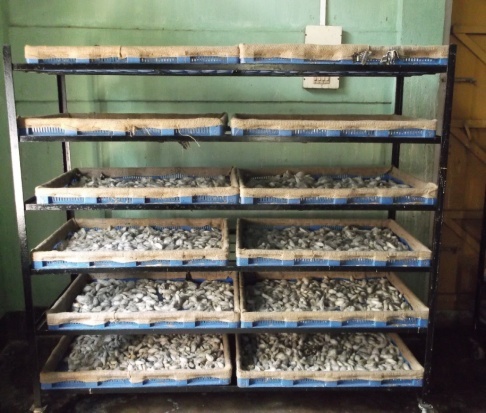
- Select cocoons based on physical characteristics e.g. compactness, shape, size and number of cocoon per kg (not more than 350 cocoons/kg).
Disinfection of grainage room
- Wash the grainage room and appliances with 5% bleaching powder solution, 3 days before consignment of seed cocoons.
- Same disinfection procedure should be adopted after completion of grainage.
- In the event of pebrine incidence during grainage, fumigate with 5% formaldehyde solution under high humid condition with the appliances inside.
- Open the room after 24 hours.

Transportation of seed cocoon
- Transport the cocoons in plastic trays during early morning or in the evening hours to avoid direct exposure to sunlight.
Storage of seed cocoon
- Seed cocoons are stored in single layers @ 500 cocoons per tray (size 3ft x 2ft) arranged in racks.
Emergence of moths and sorting of couplings:
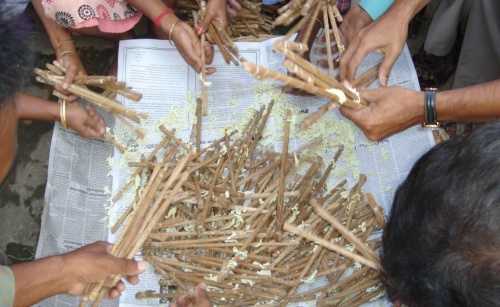
- Moth emergence occurs after 17-18 days of spinning in summer and 30 t0 35 days in winter.
- Moth emergence takes place in the evening hours as well as in the morning hours.
- Collect the emerged moths in moth cage approximately in the ratio of male :
female at 60 : 40. The paired moths are allowed to couple for 6 hrs. - Decouple the moths and allow the female moths to lay eggs on kharika/pouch.
Moth Examination
- Conduct microscopic examination of mother moths on 3rd day for basic and 0n 4th day for commercial seed following Fujiwara technique.
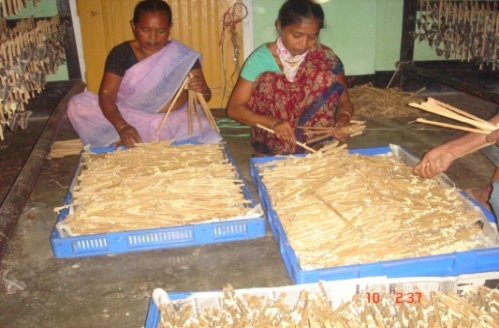
Harvesting of eggs
- Collect all the disease free layings alongwith the kharika in a tray for harvesting. Transfer the harvested eggs to a piece of nylon net for washing.
Degumming and surface sterilization of eggs
- Dip the eggs in 0.2% bleaching solution for 5 minutes.
- Wash the eggs with fresh water and soap and finally with fresh water.
- Spread the sterilized eggs on a blotting paper for drying in the shade.
- Weigh the dried eggs and pack in specially designed egg boxes for supply.
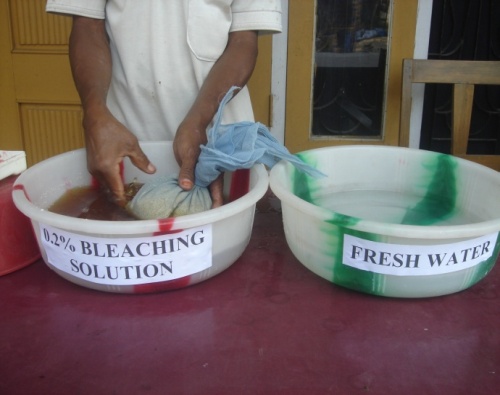
Source
Eri Silkworm Seed Production Centre, Azara, Guwahati
